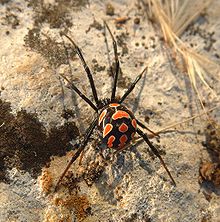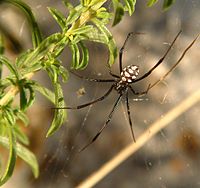| Latrodectus tredecimguttatus | |
|---|---|

| |
| Female L. tredecimguttatus, swollen with eggs | |
| Scientific classification | |
| Domain: | Eukaryota |
| Kingdom: | Animalia |
| Phylum: | Arthropoda |
| Subphylum: | Chelicerata |
| Class: | Arachnida |
| Order: | Araneae |
| Infraorder: | Araneomorphae |
| Family: | Theridiidae |
| Genus: | Latrodectus |
| Species: | L. tredecimguttatus
|
| Binomial name | |
| Latrodectus tredecimguttatus | |

| |
| Range of L. tredecimguttatus | |
| Synonyms[1] | |
| |

Latrodectus tredecimguttatus, also known as the Mediterranean black widow[2] or the European black widow,[3] is a species in the genus Latrodectus of the widow spiders. It is commonly found throughout the Mediterranean region, ranging from southern Iberia to southwest and central Asia, hence the name. Specimens from central Asia are also known by the binomial name Latrodectus lugubris; that name, however, is now considered improper, though it is still commonly found in the literature. Latrodectus tredecimguttatus was previously considered a subspecies of Latrodectus mactans.[4]
Description[edit]
L. tredecimguttatus is black in color, similar to most other widow species, and is identified by the thirteen spots which are found on its dorsal abdomen (the species name is Latin for "with thirteen spots"). These spots are usually red in colour, but may also be yellow or orange. It is otherwise similar to other species in the genus Latrodectus. The Mediterranean widow primarily lives in steppes and other grasslands, and can be a significant problem in areas where grain is harvested by hand. The female of the species has a body length of about 7–15 mm (0.28–0.59 in), while the male is smaller and reaches 4–7 mm (0.16–0.28 in) at best. Only the female spider's bite is dangerous (either for humans or cattle) as the male cannot penetrate the relatively thick epidermis.
Toxicity[edit]
Like all Latrodectus species, L. tredecimguttatus has a painful bite that is fatal in rare cases. They are not in close association with humans generally, although epidemics of bites have been reported.[5] There are many reports of Ukrainian farm workers receiving bites while working in the fields. The LD-50 of L. tredecimguttatus venom has been measured as 0.59 mg/kg,[6] and separately again as 0.59 mg/kg (with a confidence interval of 0.33–1.06).[7]
In Kazakhstan – where it has the common name karakurt (literally "black bug") – there are reports of this species biting and killing camels.[8] Pioneering entomologist Jean Henri Fabre wrote of the spider's fearsome reputation in Corsica, where it is known as the malmignatte:
I have seen her settle in the furrows, lay out her web and rush boldly at insects larger than herself; I have admired her garb of black velvet speckled with carmine-red; above all, I have heard most disquieting stories told about her. Around Ajaccio and Bonifacio, her bite is reputed very dangerous, sometimes mortal. The countryman declares this for a fact and the doctor does not always dare deny it.[9]
One crustacean-specific and two insect-specific neurotoxins have been recovered from L. tredecimguttatus, as have small peptides that inhibit angiotensin-1-converting enzyme.[10]
References[edit]
- ^ a b "Taxon details Latrodectus tredecimguttatus (Rossi, 1790)". World Spider Catalog. Natural History Museum Bern. Retrieved 2016-01-28.
- ^ Christie, A.E.; Chi, M. (2015). "Neuropeptide discovery in the Araneae (Arthropoda, Chelicerata, Arachnida): Elucidation of true spider peptidomes using that of the Western black widow as a reference". General and Comparative Endocrinology. 213: 90–109. doi:10.1016/j.ygcen.2015.02.003. PMID 25687740.
- ^ Alexakis, L.-C.; Arapi, S.; Stefanou, I.; Gargalianos, P.; Astriti, M. (2016). "Transient Reverse Takotsubo Cardiomyopathy Following a Spider Bite in Greece A Case Report". Medicine. 94 (5): e457. doi:10.1097/MD.0000000000000457. PMC 4602706. PMID 25654384.
- ^ Levy, G.; Amitai, P. (1983). "Revision of the Widow-spider genus Latrodectus (Araneae: Theridiidae) in Israel". Medicine. 77: 39–63. doi:10.1111/j.1096-3642.1983.tb01720.x.
- ^ Bettini, S. (1964). Epidemiology of latrodectism. Toxicon, 2(2), 93–102.
- ^ Rauber, Albert (1983). "Black Widow Spider Bites". Clinical Toxicology. 21 (4–5): 473–485. doi:10.3109/15563658308990435. PMID 6381753.
- ^ McCrone, J.D. (December 1964). "Comparative lethality of several Latrodectus venoms". Toxicon. 2 (3): 201–203. doi:10.1016/0041-0101(64)90023-6. PMID 14298228.
- ^ "Spiders plague Kazakh camels". BBC News. 2 July 2004.
- ^ Fabre, Jean Henri, The Life of the Spider (transl. A.T. de Mattos), Ch.1, p.40 (New York 1917).
- ^ Krasnoperov, V. G.; Shamotienko, O. G.; Grishin, E. V. (November 1990). "A crustacean-specific neurotoxin from the venom of the black widow spider Latrodectus mactans tredecimguttatus". Bioorg Khim. 16 (11): 1567–9. PMID 2096828.